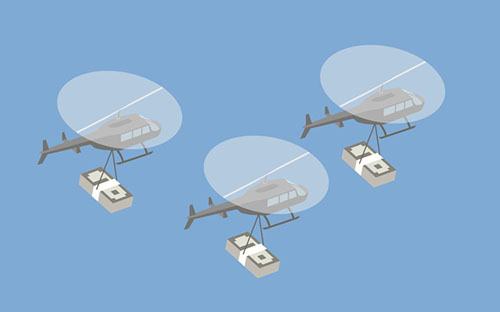Throughout the coronavirus crisis, Funds Europe presents some of the best market commentary from fund professionals. Today, Steve Donzé, senior macro strategist and investment manager at Pictet Asset Management, talks about radical Fed measures including the possibility of ‘helicopter money’.
As the US Federal Reserve takes the lead in the battle to limit economic damage from the coronavirus outbreak, it will soon have to consider policies that would have been previously dismissed as impossible. Helicopter money, or the transfer of money directly to consumers, is on the list.
The Fed has already slashed borrowing costs by 100 basis points to 0-0.25 per cent and announced plans to buy USD700 billion of bonds.
Which means most of the measures left in its policy toolkit are the controversial kind. Nevertheless, at least one of these will almost certainly be required to avoid a deflationary spiral.
Most likely is a vigorous expansion of quantitative easing (QE). The Fed has the capacity to buy up to USD3 trillion of assets, the equivalent of an additional 200 basis points of interest rate cuts. This would lift the size of its balance sheet to USD7 trillion.
Unlike previous QE programmes, though, we think the Fed’s buying spree will extend beyond US government and mortgage securities.
It could venture into corporate bonds and equities – a possibility that Boston Fed President Eric Rosengren has raised, although this requires Congress to change to the Fed’s mandate.
The US central bank might also consider Japanese-style Yield Curve Control, under which it pledges to buy an unlimited volume of Treasuries to keep the 10-year yield from rising above 1 per cent. It’s an option proposed by current Fed governors Richard Clarida and Lael Brainard, and former Fed chairs Ben Bernanke and Janet Yellen. Crucially, YCC would allow the Fed to extend its monetary stimulus without having to grow its balance sheet – avoiding a political minefield in the process.
The Fed could also take its benchmark cost of borrowing below zero. A study by the San Francisco Fed shows that reducing the effective lower bound for the fed funds rate to -0.75 per cent during the 2007-2009 crisis “would have reduced economic slack by as much as one-half at the trough of the recession and sped up the ensuing recovery”.
Beyond this point, the Fed would be venturing into uncharted territory. Among the most powerful and controversial tools at its disposal is helicopter money. An idea originally popularised by American economist Milton Friedman in the late 1960s, helicopter money is the funding of fiscal expenditures via the creation of new base money and a promise that any increase in the monetary base will not be reversed.
Essentially, it means monetary authorities give people extra money in the form of a tax cut, vouchers or an increase in public spending. At the same time, the authorities pledge that they will not raise taxes at a later date to recoup the additional funds.
As Friedman himself explained: “Let us suppose now that one day a helicopter flies over this community and drops an additional USD1,000 in bills from the sky, which is, of course, hastily collected by members of the community. Let us suppose further that everyone is convinced that this is a unique event which will never be repeated.”
Bernanke, a helicopter money advocate, has in the past proposed a money-financed fiscal programme, which would involve either an increase in public spending or a tax cut that is financed with newly printed money.
Other countries are already experimenting with helicopter money. Hong Kong announced last month that it will be giving each of its adult citizens a one-off cash payment of USD1,284 to prop up the virus-hit economy, and Australia is also considering cash handouts. Several Arabian Gulf economies did the same during the Arab Spring unrest in 2011.
In the case of Hong Kong and Australia, however, there’s nothing stopping consumers to save, rather than spend, the windfall.
Japan’s trial of helicopter money may be more effective in forcing consumers to spend today. In 2019, it introduced a programme which allows eligible households to buy so-called “premium” shopping vouchers to mitigate the effect of a VAT hike. The vouchers, offered at a 20 per cent discount, can be used to pay for goods and services at stores and hospitals designated by municipalities but they expire at the end of March.
The Fed can take a similar approach. It can give every US household USD1,000 with a certain expiry date to force consumers to spend.
Desperate times call for desperate measures – the Fed may well resort to deploying the helicopters to pre-empt deflationary risks.
© 2020 funds europe





